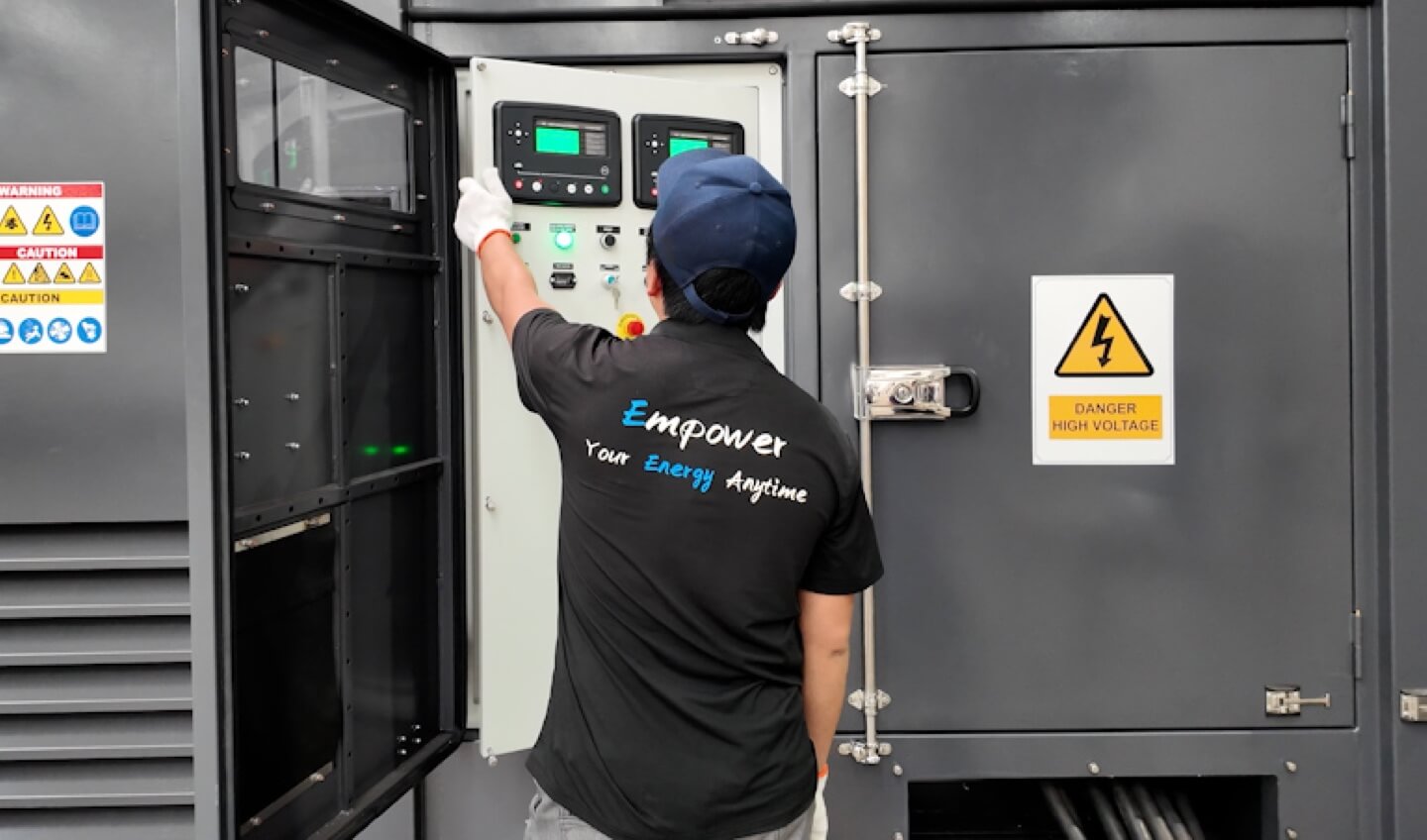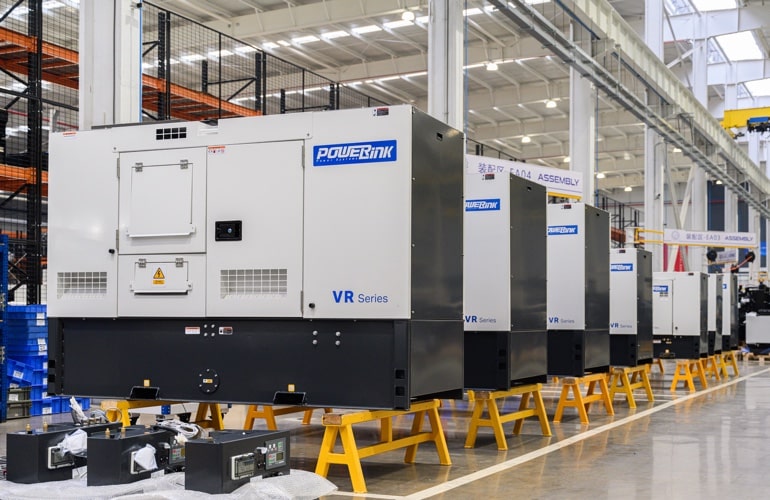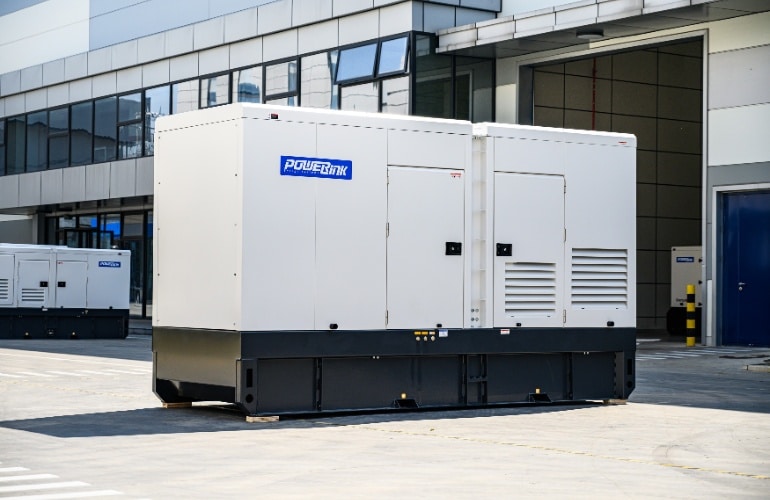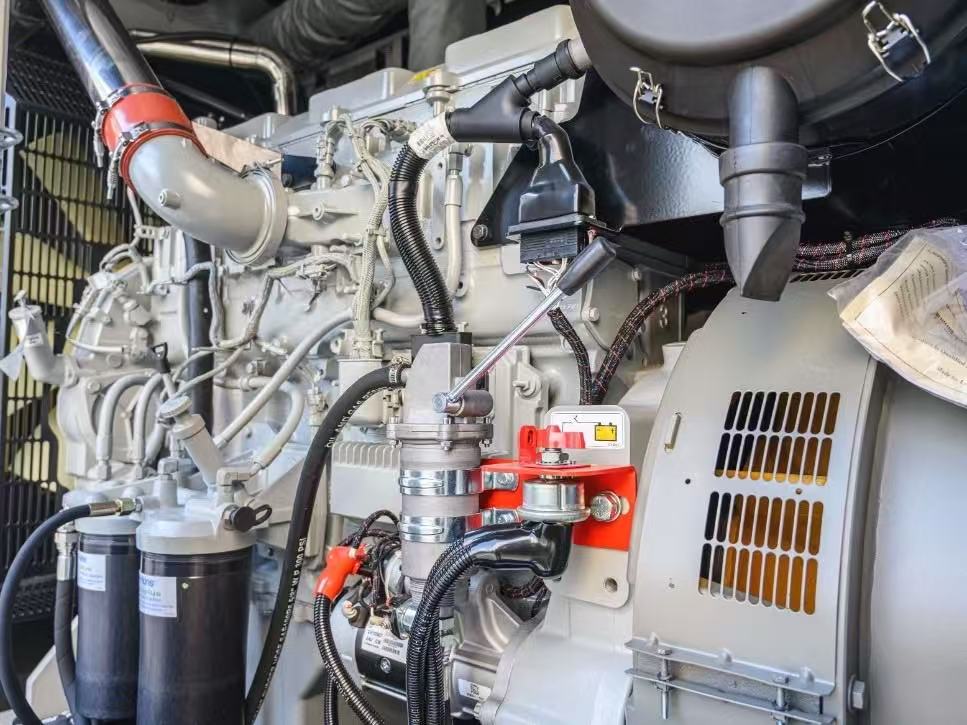Generators are essential backup power sources for homes, businesses, and critical facilities. Standby generators are often rarely run, which means monthly testing and a maintenance schedule are critical to ensure problems don’t occur without the operator’s knowledge.
In this guide, we’ll explore the 10 most common generator problems, their solutions, and how to ensure optimal performance through preventative maintenance. If you’ve been facing generator problems, PowerLink’s expert generator services can help. Here are some of the most common reasons why a standby generator may not be working and their solutions.
1. The Battery Fails
Battery failure is one of the most common reasons why a generator will not start. This problem can occur for a variety of reasons, and understanding them is critical to ensuring reliable performance.
One common cause is sulfation – the buildup of lead sulfate crystals on the plates of lead-acid batteries. When a battery is deeply discharged, sulfate molecules in the electrolyte crystallize. These deposits clog the plates and restrict current flow, ultimately preventing the generator from starting.
Another common cause is a tripped charger circuit breaker or a faulty battery charger. It is not uncommon for a charger to lose power or the AC circuit breaker to trip after routine maintenance or repairs. Without a charging source, even healthy batteries can quickly die. Therefore, it is important to double-check the charger’s circuit breaker switch after any repair activity to ensure it is properly supplying power.
Additionally, loose or corroded battery connections can cause erratic performance. These parts should be regularly inspected, cleaned, and tightened as part of routine maintenance to avoid unexpected failures.
Over time, batteries degrade due to age, environmental stress, and load demands. They lose their ability to store charge, especially in portable generators or rental units where other equipment may be consuming power even when the generator is off. In this case, a pull starter may temporarily help start the engine, but it is not a sustainable solution. Monitoring battery health and understanding the battery life of your generator is critical to timely battery replacement and avoiding costly downtime.
Solution:
- To avoid these issues, implement the following battery maintenance best practices:
- Test battery voltage regularly to monitor health.
- Clean terminals and connections to keep circuits open.
- Replace batteries every 2-3 years or as per manufacturer’s guidelines.
- Install a trickle charger or automatic battery maintainer for your backup generator to keep batteries in good condition and prevent deep discharge.
Before each operation, check all battery-related components, including chargers and cables, to ensure they are in good working condition.
By proactively managing your generator’s battery health, you can prevent failed starts, extend battery life, and ensure your generator is always ready for use.
2. Generator Won’t Start
There are many reasons why a generator may not start, ranging from simple repairs to serious problems. Low fuel, lack of oil, damaged or broken spark plugs, and carburetor fouling can all cause a generator to not start. In addition to this, a generator may not start due to a closed fuel valve, a tripped circuit breaker, or a faulty sensor.
Solution:
First, double-check that your generator’s control panel is properly set to automatic operation. If the main switch is not in the correct “auto” or “run” mode (especially after maintenance or an emergency stop), your generator will not start properly during a power outage. After maintenance, the system is usually in the “off” or “reset” position.
If you are still experiencing starting problems, follow this basic checklist:
- Check the fuel level to confirm that the generator is not simply out of oil.
- Check the fuel line and shutoff valve to ensure that there are no obstructions and that the oil flow is on.
- Reset any tripped circuit breakers that may be disconnecting critical power pathways.
- Test all engine sensors and replace any that are reading incorrectly or have failed.
For gasoline generators, a faulty ignition component may also be the culprit. Check the spark plugs and ignition coils, both of which degrade over time. Use an ignition spark tester to confirm that the spark plugs are drawing the correct current. Also, test the ignition coil to ensure that it is producing enough voltage to ignite the spark plugs. If any component is faulty, replace the relevant component before trying to restart the generator.
3. The System Stalls During Operation
Overheating, overloading, and erratic fuel delivery are the most common causes of mid-operation stalls. When a generator is operating beyond rated capacity or is not cooling enough due to insufficient coolant or airflow issues, the engine may shut down to protect itself from damage.
For natural gas generators, dirty spark plugs can also cause erratic performance. Dirty or worn spark plugs can prevent efficient combustion, reduce the generator’s ability to produce a consistent power output, and cause it to malfunction or stop operating altogether.
For diesel generators, the problem may be in the fuel system. A faulty fuel pump, clogged fuel lines, or fuel contamination can disrupt the steady flow of fuel needed to keep the engine running. If the fuel is of poor quality (containing water, debris, or microorganisms), it can damage internal components and cause the fuel pump and fuel hoses to clog.
Solution:
- Check coolant levels and ensure the generator is not overheating.
- Verify the electrical load does not exceed generator capacity.
- Inspect and clean spark plugs if using a gas generator.
- Test the fuel pump and lines for clogs or contamination in diesel systems.
- Use only high-quality fuel and replace filters regularly.
4. Low Coolant Levels
Coolant is essential for regulating the engine temperature of your generator. If the radiator is low on coolant, the engine can quickly overheat, causing severe mechanical damage and eventually engine failure. To prevent this from happening, the coolant level should be checked regularly, preferably before each use or during regular maintenance cycles. Most generators use colored coolant (usually red, but this can vary between manufacturers) to facilitate visual inspection.
In some cases, a low coolant shutdown is not caused by an actual loss of coolant, but rather a plugged radiator core. Here’s how this happens: When the generator is running at full load and the engine is at optimal operating temperature, the thermostat opens fully, allowing the coolant to circulate. If the radiator core becomes plugged, the coolant cannot flow freely. Excessive pressure forces the coolant out through the overflow tube.
Once the engine cools down, the thermostat closes and the overall coolant level decreases, triggering a shutdown due to the sensed low coolant level. Since this condition only occurs at high operating temperatures, it can be difficult to diagnose during idle testing.
Solution:
- Check and top off coolant levels routinely.
- Look for signs of external or internal coolant leaks.
- Use the correct coolant mixture and never substitute water alone.
- Flush and replace coolant according to the manufacturer’s schedule.
5. You’re Experiencing Leaks
If you continue to top up your coolant and the level is still low, your generator is most likely leaking. Promptly identifying and addressing the source of the leak is key to avoiding further damage.
Here are some of the most common causes of generator coolant leaks:
Faulty Block Heater Hose: Block heaters heat the coolant to help the engine start smoothly in cold conditions, which reduces wear and tear on other systems. However, the high temperatures they generate can damage standard rubber hoses over time, causing coolant leaks. To prevent this, use high-temperature silicone hoses and replace them as part of your maintenance schedule every 3-4 years.
Leaking Crankcase Breather: The crankcase breather vents excess gas from the engine, but it also vents oil, which can create visible puddles around the generator. To reduce oil loss, consider installing a recirculating breather that returns vapors to the system instead of venting it to the outside.
Wet Buildup: Wet buildup is common in diesel generators and is when unburned fuel, oil, and water vapor build up in the exhaust system, eventually dripping out as a thick, dark residue. This is not only an indication of fluid loss, but also inefficient combustion. Running the generator under load periodically will help burn off excess sediment and prevent wet buildup.
6. Bad Fuel Mix
Fuel-related issues are a leading cause of generator failure. A bad fuel mix disrupts combustion and prevents the engine from starting or running smoothly.
This can happen in several ways:
Empty fuel tank: When fuel runs out, the engine receives air but no fuel, preventing ignition.
Clogged air intake: If airflow is restricted, the engine gets fuel but insufficient air, disrupting the fuel-air ratio.
Incorrect fuel delivery: The system may supply too much or too little fuel, leading to incomplete or inefficient combustion.
Contaminated fuel: Water or other impurities in the tank—especially from long-standing or poorly stored fuel—can prevent proper ignition and damage components over time.
Solution:
To avoid these issues, make fuel testing a routine part of generator maintenance. Regularly inspect tanks for contamination, ensure filters are clean, and verify that the air intake system is unobstructed..
7. Your Fuel Gauges Are Incorrect
Fuel depletion is a common issue in both diesel and natural gas generators—often made worse by inaccurate fuel gauge readings. Mechanical fuel gauges can become stuck or faulty, failing to reflect actual fuel levels. Additionally, sludge buildup in fuel filters can restrict flow, causing the generator to run dry even when fuel remains in the tank.
Solution:
To prevent unexpected shutdowns, regularly inspect and calibrate fuel gauges, replace clogged filters, and consider upgrading to digital monitoring systems for more reliable readings.
8. There Are Clogs in the Line
Clogged fuel lines are a common cause of generator failure. The fuel line is responsible for delivering fuel to the engine, but any blockage can interfere with fuel flow, causing reduced performance or even a complete shutdown. Clogs can occur in the fuel tank, fuel valve, or carburetor, usually due to debris, sludge, or fuel deterioration.
Solution:
To keep your generator running smoothly, regularly inspect and clean the fuel lines, replace the fuel filter as needed, and use high-quality, stable fuel to prevent fuel buildup.
9. The High Fuel Level Alarm Activates Unnecessarily
Overfilling the fuel tank can cause issues like wet stacking and fuel leaks, which is why generators are equipped with high fuel level alarms to prevent overfilling. These alarms are typically accurate, alerting you to stop refueling when levels are too high.
However, in rare cases, natural thermal expansion—especially on hot days—can cause the fuel to expand and trigger the alarm even if the tank isn’t overfilled.
Solution:
To avoid false alarms, monitor refueling carefully, allow room for fuel expansion, and ensure the alarm sensor is properly calibrated.
10. Controls Not in Auto
When your control panel displays the “Non Auto” message, it is due to human error, usually caused by the main control switch being in the off/reset position. When the main control switch is in this position, the generator may not start when power is lost.
Solution:
Check your generator’s control panel regularly to make sure the “Non Auto” message is not displayed. There are many other faults displayed on the control panel that can cause the generator to not start.
How to Prevent Generator Issues with Preventive Maintenance?
Preventive maintenance is the most effective way to ensure your generator performs reliably when you need it most. A well-maintained generator experiences fewer failures, lasts longer, and runs more efficiently. Here’s how to stay ahead of problems:
Follow a Scheduled Maintenance Plan
Create a logbook with monthly, quarterly, and annual tasks. Common tasks include oil changes, battery tests, air filter replacements, and coolant flushes.
Use High-Quality Parts and Fluids
Never cut corners on replacement components. Use OEM parts and high-grade fuel and lubricants to reduce wear and tear.
Run the Generator Regularly
Exercise the unit weekly or monthly to prevent carbon buildup and ensure fluid circulation.
Keep Records
Document every service visit, inspection, or repair. This helps identify patterns and provides valuable data for technicians.
Schedule Professional Inspections
Partner with certified technicians for in-depth inspections, load bank testing, and diagnostics that go beyond surface checks.
Request Generator Services from PowerLink
If you’re experiencing any of the issues listed above or simply want peace of mind, PowerLink’s expert generator services are just a call away. We offer:
- 24/7 emergency repairs
- Routine maintenance plans
- Installation and commissioning
- Remote monitoring solutions
- Genuine parts and accessories
With decades of experience and a commitment to reliability, PowerLink ensures your generator is always ready when you need it most. Contact us today to schedule a maintenance check or consultation.






